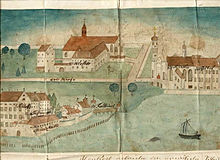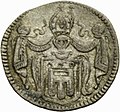Langenargen Mint
The Langenargen mint was a mint of the Counts of Montfort in Langenargen on Lake Constance .
Münzhof
The Münzhof is one of the oldest buildings from the Montfort period. The first building was destroyed by the Swedes in 1632 during the Thirty Years War . On July 10, 1733, the mint, which had been rebuilt in 1674, was struck by lightning and burned down together with the tithe barn in its vicinity . The outbuildings of the castle on the peninsula of the Argen moated castle in the immediate vicinity of the Capuchin monastery then served as the mint for a few decades . In 1763 the mint in Langenargen was finally closed.
The tithe barn, now known as the Münzhof, was rebuilt in 1735. After the Second World War , the community used the building as a construction yard and set up several apartments on the upper floor. The public "library in the Münzhof" and a multi-purpose hall have been there since May 1988.
history
In the tipper time 1621 a group organized by entrepreneurs, with the approval of the counts of Montfort the mint in Langenargen and coined there under addition of copper, tin or lead inferior crowns and three Bätzner , d. H. 12 cruiser pieces. Because since a resolution by the German princes in 1623 only coins with a high silver content were allowed, Count Hugo von Montfort bought the worthless tipper coins in large quantities at the scrap metal price and mainly minted half-chunks of the silver contained therein, i.e. H. 2 cruiser pieces. On the southern German probation day in Augsburg in May 1626, however, these coins were also found to be defective and banned, and the mint master and Wardein were invited to Nuremberg with the coin books on the next probation day. However, the Montfort mint was only operated by a non-sworn mint and for the probation day of 1626 in Nuremberg only an "extract" was sent instead of the books requested. The count was then asked until 1630 to send the coin books and two responsible officials to the probation day, but instead only a letter of apology from the count regularly came. Count Hugo stopped minting change in 1629, presumably because his silver supplies were exhausted. On the probation day in October 1630 in Regensburg, he finally sent the coin books that had been requested for several years. From them it emerged that from 1626 to 1629, in spite of the ban, he had half-chunks minted for more than 300,000 guilders, i.e. more than nine million pieces.
From 1675, large numbers of coins were minted in the Montfort mint, but in December 1679 all Montfort coins were declared illegal in three southern German districts and withdrawn from circulation for one sixth below their face value. Even so, the mint was in operation with only a few interruptions until 1763. The Montfort money was regularly criticized, disreputed and banned during the audits of the districts. It was temporarily not accepted in Frankfurt am Main either.
In 1722 there was a scandal because of the forgery of Konstanzer Ratsschillingen in the Langenargen mint, but Count Anton III. von Montfort did not consider himself responsible, as he had not forged himself but leased the mint. From 1734 gold coins were minted in the Langenargen mint. In 1736 a coin patent issued by the Franconian District warned against these gold-minted carolines, and in 1737 they were banned in Franconia . In 1749 all Montfort gold coins were banned in Hanover .
The Counts of Montfort minted coins especially when the sales opportunities outside their own country were good. They minted 2/3 thalers when they could earn 2/3 thalers from exporting and small change when half-cruisers and cruisers could be accommodated better. If the minting of a coin type promised a profit, they supplied the market, regardless of whether it was in gold, silver or copper. But they also minted "Rentkreuzer" exclusively for circulation in their own Montfortic country, as their face value did not correspond to the silver value. The rent cruisers with a low silver content were issued with the instruction that they should be used to pay the next due taxes, whereby they would not be credited to the silver value but to the full face value.
From 1760 onwards, anyone using Montforter coins was supposed to pay a fine according to an imperial mandate. Nevertheless, the last years of the Montfort coins still in existence are heavily worn and must have been in circulation a lot. In 1763 the Langenargen mint was closed by Count Franz Xaver. However, he kept the mint with all its accessories in the hope of minting coins there again at a later date.
literature
- Ulrich Klein: The Langenargen Mint. In: Langenargener story (s). Volume 4, 1989, pp. 97-109.
References and comments
- ↑ Historical data on the municipality of Langenargen
- ↑ Probation day: a meeting introduced in the 16th century of mint masters, wardens and emissaries from the various mint states of an imperial circle, who supervised the coins minted in the circle. Quoted from: Helmut Kahnt, Bernd Knorr: Old measures, coins and weights. A lexicon. Bibliographisches Institut, Leipzig 1986, licensed edition Mannheim / Vienna / Zurich 1987, ISBN 3-411-02148-9 , p. 394.
- ↑ a b c d e Joachim Stollhoff: The Counts of Montfort and their coinage.
- ^ Old German coins and medals: Montfort, Grafschaft. Ulrich, 1564-1574.
Coordinates: 47 ° 35 '49.56 " N , 9 ° 32" 10.32 " E.



